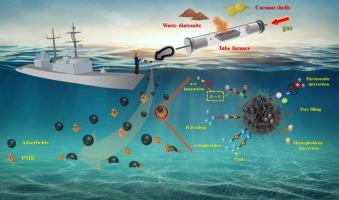Turn waste to wealth: Modification of coconut shells and waste diatomite from brewery for efficient adsorption of polycyclic aromatic hydrocarbons (PAHs) in seawater
IF 8.1
1区 工程技术
Q1 ENGINEERING, CHEMICAL
引用次数: 0
Abstract
Polycyclic aromatic hydrocarbons (PAHs) enter marine ecosystems, posing risks to human health and the environment. This study investigated the adsorption properties of phenanthrene (Phe), pyrene (Pyr), and benzo[a]pyrene (BaP) from seawater using an efficient adsorbent made from brewery waste diatomite and coconut shells. The optimal adsorbent was produced by calcining at 700 °C for 2 h with a 4:1 diatomite to coconut shell ratio. Under optimal conditions (0.4 g/L of dosage, pH = 7, salinity = 30, 9 mg/L of dissolved oxygen), removal rates reached 92.81 % for Phe, 96.93 % for Pyr, and 99.48 % for BaP. Adsorption mechanisms were analyzed through kinetics, thermodynamics, and density functional theory, revealing both physical interactions (pore filling, electrostatic interactions, hydrophobic effects) and chemical interactions (π-π interaction, functional group action, complexation reaction). Tests in actual seawater confirmed that the adsorbent effectively captures up to 85 %-95 % of PAHs during sedimentation, sequestering them in the seabed. This work presents a novel, eco-friendly solution for PAHs removal from seawater, contributing to water treatment and resource utilization.

求助全文
约1分钟内获得全文
求助全文
来源期刊

Separation and Purification Technology
工程技术-工程:化工
CiteScore
14.00
自引率
12.80%
发文量
2347
审稿时长
43 days
期刊介绍:
Separation and Purification Technology is a premier journal committed to sharing innovative methods for separation and purification in chemical and environmental engineering, encompassing both homogeneous solutions and heterogeneous mixtures. Our scope includes the separation and/or purification of liquids, vapors, and gases, as well as carbon capture and separation techniques. However, it's important to note that methods solely intended for analytical purposes are not within the scope of the journal. Additionally, disciplines such as soil science, polymer science, and metallurgy fall outside the purview of Separation and Purification Technology. Join us in advancing the field of separation and purification methods for sustainable solutions in chemical and environmental engineering.
 求助内容:
求助内容: 应助结果提醒方式:
应助结果提醒方式:


